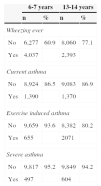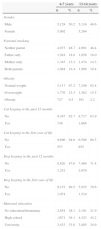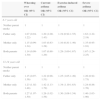To evaluate the exposure to environmental tobacco smoke (ETS) of the childhood population in this community and its relationship with asthma symptoms.
MethodsA cross-sectional study was conducted using the International Study of Asthma and Allergies in Childhood (ISAAC) questionnaire on children and adolescents in this community. The symptoms “wheezing ever”, “current asthma”, “severe asthma”, and “exercise-induced asthma” were defined by this questionnaire. Parental smoking was classified into four mutually exclusive categories: 1) no parent smokes; 2) only the mother smokes; 3) only the father smokes; and 4) both parents smoke. The odds ratio of the prevalence of asthma symptoms according to ETS exposure was calculated using logistic regression.
ResultsA total of 10,314 children and 10,453 adolescents were included. Over 51% of the children and adolescents were exposed to ETS at home. ETS is associated with a higher prevalence of asthma symptoms, particularly if the mother or both parents smoke.
ConclusionThe prevalence of ETS is still high in this community, although there has been a decreasing tendency in the last 15 years. ETS is associated with higher prevalence of asthma.
Avaliar a exposição da população infantil à FCA em nossa comunidade e sua relação com os sintomas de asma.
MétodosFoi realizado um estudo transversal usando o questionário de estudo ISAAC em crianças e adolescentes da nossa comunidade. Pelo questionário, fez-se a definição por “já ocorreu sibilância”, “asma atual”, “asma grave” e “asma induzida pelo exercício”. O tabagismo parental foi classificado em quatro categorias mutuamente excludentes: 1) nenhum dos pais fuma; 2) somente a mãe fuma; 3) somente o pai fuma; e 4) ambos os pais fumam. Calculou-se a odds ratio da prevalência de sintomas de asma, de acordo com a exposição à FCA, usando regressão logística.
ResultadosForam incluídas, no total, 10.314 crianças e 10.453 adolescentes. Mais de 51% das crianças e adolescentes foram expostos à FCA em casa. A FCA se associa a uma prevalência mais alta de sintomas de asma, particularmente se a mãe ou ambos os pais fumam.
ConclusõesA prevalência da FCA continua a ser alta em nossa comunidade, embora com uma tendência para diminuição nos últimos 15 anos. A FCA se associa a uma prevalência mais alta de asma.
Environmental tobacco smoke (ETS) is associated with a higher prevalence of asthma in adolescents, and with more severe forms in children. Passive exposure to tobacco smoke is common, and its damaging effects on health have been well-known for decades.1 However, the magnitude of the problem worldwide is poorly described2.
Childhood asthma is one of the diseases that most contributes to the health costs arising from passive smoking.2
It was estimated that 603,000 deaths were attributable to second-hand smoke in the year 2004, representing 1% of world mortality, of which 28% occurred in children.2Although the higher prevalence and severity of childhood asthma due to ETS appears to be well-established,3–6 other studies report that ETS is not associated with a higher prevalence of asthma in children.7–9
The aim of the present study was to analyze the prevalence of asthma symptoms in children and adolescents in this community, according to the passive exposure to smoking by the parents.
Material and methodsA cross-sectional study on the child and adolescent population was conducted in the Autonomous Community of Galicia, Spain), following the methodology of the International Study of Asthma and Allergies in Childhood (ISAAC) using a questionnaire, which was previously translated and validated in Spanish.10,11
The study was conducted in six of the seven health areas of the region, which included 69% of the total population (1.9 million inhabitants). The schools required to obtain 1,000 valid questionnaires in each age group were randomly selected. All children of 6 to 7 years and 13 to 14 years from each school were included. The schools that declined to participate were replaced with others.
The fieldwork was conducted between October, 2006 and February, 2007. The remaining health area was excluded, as a study was conducted there three years prior, and these results are included in other publications.10,11
Permission was requested from the parents or guardians of the children, who also answered the questions in the questionnaire for the 6 to 7 year-old children. The 13 to 14 year-old group completed the questionnaire themselves.
The questionnaire data were entered manually into a database in accordance with the ISAAC protocols, using double entry with subsequent validation.
The environmental questionnaire included questions about asthma symptoms, self-reported height and weight, presence of a dog or cat in the home, parental smoking habits, and maternal education level.
For the purpose of this study, the symptom “wheezing ever” was defined as a positive answer to the question “Has your child ever had wheezing or whistling in the chest at any time in the past?”.
The symptom “current asthma” was defined as a positive answer to the question “Has your child had wheezing or whistling in the chest during the last 12 months?”.
The symptom “severe asthma” was defined as a combination of the three questions assessing the severity of asthma: “How many wheezing attacks has your child had during the last 12 months?” (none, one to three, four to 12, more than 12); “In the last 12 months, on average how often has your child's sleep been disturbed due to wheezing?” (never, < one night/week, ≥ one nights/week); and “In the last 12 months, has wheezing been severe enough to limit your child's speech to only one or two words at a time between breaths?”. Children were considered to have current severe asthma when there were ≥ four asthma attacks or when sleep was disturbed ≥ one nights/week, or when there had been an episode of speech limitation.
The symptom “exercise-induced asthma” was defined as a positive answer to the question, “In the last 12 months, has your child's chest sounded wheezy during or after exercise?”.10,12,13
Parental smoking was classified, based on the responses in the questionnaire, into four mutually exclusive categories: 1) no parent smokes; 2) only the mother smokes; 3) only the father smokes; and 4) both parents smoke.
Obesity and overweight were defined in accordance with the body mass index (BMI) cut-off points set by Cole et al., for each group by age and gender.14
The educational level of the mother was classified into three categories: 1) No education or only primary school education; 2) secondary school education; 3) university education.
The study was approved by the Clinical Research Ethics Committee of Galicia.
Statistical analysisMultiple logistic regression was used to obtain adjusted prevalence odds ratios (OR) and 95% confidence intervals (95% CI) between asthma symptoms of the schoolchildren and parental smoking. Children whose both parents did not smoke were used as a control group.
In the multivariable analysis the results presented are adjusted for gender, obesity, maternal education level, and cat and dog exposure. Children with incomplete data were excluded from the study. The statistical analysis was performed using the Statistical Package for Social Sciences (SPSS) 17.0 software
ResultsThe response rate in the 6 to 7 year-old group was 72.4%, with 10,314 valid cases. The response rate was higher (84.4%, 10,453 cases) in the adolescent group.
The prevalence of asthma in the children's group was 39.1%; of current asthma, 13.5%, severe asthma, 4.8%, and exercise-induced asthma, 6.4%. In the adolescent group these prevalences were 22.9%, 13.1%, 5.8%, and 19.8%, respectively (Table 1).
Prevalence of asthma symptoms.
| 6-7 years | 13-14 years | |||
|---|---|---|---|---|
| n | % | n | % | |
| Wheezing ever | ||||
| No | 6,277 | 60.9 | 8,060 | 77.1 |
| Yes | 4,037 | 2,393 | ||
| Current asthma | ||||
| No | 8,924 | 86.5 | 9,083 | 86.9 |
| Yes | 1,390 | 1,370 | ||
| Exercise induced asthma | ||||
| No | 9,659 | 93.6 | 8,382 | 80.2 |
| Yes | 655 | 2071 | ||
| Severe asthma | ||||
| No | 9,817 | 95.2 | 9,849 | 94.2 |
| Yes | 497 | 604 | ||
All values as number of cases (n) and percentage (%).
In the 6-7 year-old group, only the father smoked in 18.8% of the cases, only the mother in 13.1%, both parents in 19.4%, and neither parent smoked in 48.7% of the cases. In the adolescent group, neither parent smoked in 48.4% of the cases, only the father smoked in 18.1%, only the mother in 14.2%, and both parents were smokers in 19.3% of the cases (Table 2).
Main characteristics of the children and prevalence of risk factors.
| 6-7 years | 13-14 years | |||
|---|---|---|---|---|
| n | % | n | % | |
| Gender | ||||
| Male | 5,128 | 50.2 | 5,116 | 49.6 |
| Female | 5,092 | 5,204 | ||
| Parental smoking | ||||
| Neither parent | 4,973 | 48.7 | 4,991 | 48.4 |
| Father only | 1,918 | 18.8 | 1,856 | 18.0 |
| Mother only | 1,345 | 13.2 | 1,474 | 14.3 |
| Both parents | 1,984 | 19.4 | 1,999 | 19.4 |
| Obesity | ||||
| Normal weight | 5,117 | 67.2 | 7,246 | 82.4 |
| Overweight | 1,776 | 23.3 | 1,362 | 15.5 |
| Obesity | 727 | 9.5 | 191 | 2.2 |
| Cat keeping in the past 12 months | ||||
| No | 9,387 | 92.7 | 8,717 | 83.9 |
| Yes | 736 | 1,668 | ||
| Cat keeping in the first year of life | ||||
| No | 9,696 | 94.6 | 6,586 | 88.5 |
| Yes | 557 | 855 | ||
| Dog keeping in the past 12 months | ||||
| No | 8,820 | 87.6 | 7,409 | 71.4 |
| Yes | 1,252 | 2,970 | ||
| Dog keeping in the first year of life | ||||
| No | 9,153 | 89.5 | 5,935 | 79.6 |
| Yes | 1,074 | 1,519 | ||
| Maternal education | ||||
| No education/elementary | 2,854 | 28.1 | 2,191 | 21.9 |
| High school | ,3871 | 38.1 | 4,323 | 43.2 |
| University | 3,433 | 33.8 | 3,485 | 34.9 |
All values as number of cases (n) and percentage (%).
In the multivariable analysis, parental smoking was associated with a higher prevalence of all forms of asthma in the adolescent population, particularly if the mother, or both parents smoked. The greatest effect was observed for “recent wheezing”, with a prevalence OR of 1.42 (95% CI: 1.13-1.79) when only the mother was a smoker (Table 3).
Odds ratio for prevalence of asthma symptoms according to parental smoking in children and adolescents.
| Wheezing ever | Current asthma | Exercise-induced asthma | Severe asthma | |
|---|---|---|---|---|
| OR (95% CI) | OR (95% CI) | OR (95% CI) | OR (95% CI) | |
| 6-7 years old | ||||
| Neither parent smoke | 1 | 1 | 1 | 1 |
| Father only | 1.07 (0.94-1.22) | 1.20 (1.00-1.43) | 1.19 (0.92-1.55) | 1.63 (1.22-2.19) |
| Mother only | 1.15 (0.99-1.34) | 1.03 (0.83-1.28) | 1.10 (0.81-1.49) | 1.35 (0.95-1.91) |
| Both parents | 1.14 (0.99-1.30) | 1.07 (0.88-1.29) | 1.29 (1.00-1.67) | 1.67 (1.24-2.25) |
| 13-14 years old | ||||
| Neither parent smoke | 1 | 1 | 1 | 1 |
| Father only | 1.15 (0.97-1.36) | 1.22 (0.98-1.51) | 1.25 (1.05-1.49) | 1.26 (0.92-1.73) |
| Mother only | 1.23 (1.02-1.48) | 1.42 (1.13-1.79) | 1.34 (1.10-1.63) | 1.24 (0.88-1.76) |
| Both parents | 1.27 (1.07-1.50) | 1.26 (1.02-1.56) | 1.30 (1.08-1.54) | 1.40 (1.03-1.90) |
CI, confidence interval; OR, odds ratio.
Adjusted by gender, cat and dog keeping, maternal education, and parental smoking.
In children, the more significant relationship was with severe asthma, where the prevalence OR was 1.63 (95% CI: 1.22-2.19) when only the father smoked, and 1.67 (95% CI: 1.24-2.25) when both parents smoked (Table 3). In this age group no significant relationship between parental smoking and the symptom wheezing ever was found. Also, no effect when only the mother was a smoker was observed (Table 3).
DiscussionThe results of the present study show that the prevalence of asthma symptoms increases with the exposure to parental smoking, particularly in adolescents.This is in agreement with the majority of published studies, which observe a clear damaging effect of parental smoking on the respiratory health of their children.2,15,16Some authors present differing results, showing no significant relationship between ETS and asthma in children.7–9
The study by Hatakka included 594 children from 1 to 6 years old, with a low asthma prevalence of 0.9% before 3 years of age, and 5.5% between 4-6 years of age. The small sample size, the age group included, and the low asthma prevalence are factors that can influence the result of an absence of a relationship between ETS and childhood asthma.8
A study conducted in Macedonia included 3,026 children aged 13 to 14 years old. This lower sample size used, along with the lower prevalence of current wheezing, which was 8.8%, lower than the 13% of the present study's population, could explain the lack of significant relationships between ETS and asthma symptoms. However, a significant association was observed for night-time cough, with a prevalence of 16.5%.7
The study by Akçakaya included a population of 2,276 children from 6-15 years. The prevalence of passive smoking was very high, at 67%, but that of asthma was low, showing 7.2% for current wheeze. This low prevalence of symptoms and the lower sample size could explain, at least partially, the lack of effect.9It is also well known that the influence of other environmental factors, as well as the different distribution of common risk factors can alter the results.17
In the present study study it was demonstrated that exposure to parental smoking continues to be high in this community (greater than 51% in both age groups), although a decreasing tendency is observed when compared with another study conducted between 1990 and 1992 with a 6-18 year-old population from the same community, in which the prevalence of parental smoking was 57% for boys, and 55% for girls.18
The association between ETS and asthma appears to be stronger in adolescents than in children. Some authors have obtained similar results, with a more consistent relationship in adolescents;19 others in children;20 and others have obtained a similar association in both age groups.21
In any case, at least part of the differences between the two age groups could be due to the methodology of the ISAAC study, since the parents of the 6-7 year-old children responded, while the in the 13-14 year age group, the adolescents themselves completed the questionnaire, which may alter the perception of the symptoms.22,23
A stronger association of ETS with asthma was also observed in cases where both parents were smokers, which suggests a possible dose-dependent relationship, in agreement with that mentioned by other authors.16,18 In the cases of only one parent smoking, the stronger association was with maternal smoking, a fact repeatedly mentioned in the literature. The greater effect of maternal smoking appears to be reasonable, since this negative effect may already have began in the fetal stage of development; additionally, the relationship of the child with the mother is usually much closer than with the father.1,15
Several pathophysiological mechanisms appear to support this harmful effect of ETS on the respiratory system of children. This effect may depend on exposure during pregnancy, since mothers who smoke do not usually give up this habit during pregnancy.24–26 It is known that smoking during pregnancy affects fetal development and lung maturation, the development of the pulmonary immune system, prematurity, and intrauterine growth retardation, which lead to smaller airways.1,5,27–29
After birth, ETS can lead to direct toxicity in the airways, oxidative damage, recruitment of inflammatory cells, increasing neutrophilic inflammation, an increase in epithelial permeability, disposition to respiratory infections, allergic sensitization, poor response to corticoid treatment, and changes in the cytokine profile.15,30–32
The present study has some limitations. Due to its cross-sectional design, a causal relationship cannot be established between ETS and asthma. Also, the data came from a questionnaire, with no objective measurement of exposure to smoking. It is worth mentioning that the validity of questionnaires to evaluate smoking in epidemiological studies is widely contrasted. Several studies have shown a good correlation between smoking evaluated by questionnaire and environmental nicotine levels.33,34
The present study's strengths include the large sample of randomly selected children and adolescents included in the study, and the use of the widely validated ISAAC study methodology.
In conclusion, the relationship between ETS and asthma symptoms in children and adolescents in this community appears robust. Likewise, exposure to ETS is common, although it presents a slight decreasing.
FundingThis work was founded by Maria Jose Jove Foundation.
Conflicts of interestThe authors declare no conflicts of interest.
The authors would like to thank David Brown for his help with the English version of this article.
Please cite this article as: Gonzalez-Barcala FJ, Pertega S, Sampedro M, Lastres JS, Gonzalez MA, Bamonde L, et al. Impact of parental smoking on childhood asthma. J Pediatr (Rio J). 2013;89:294–9.













